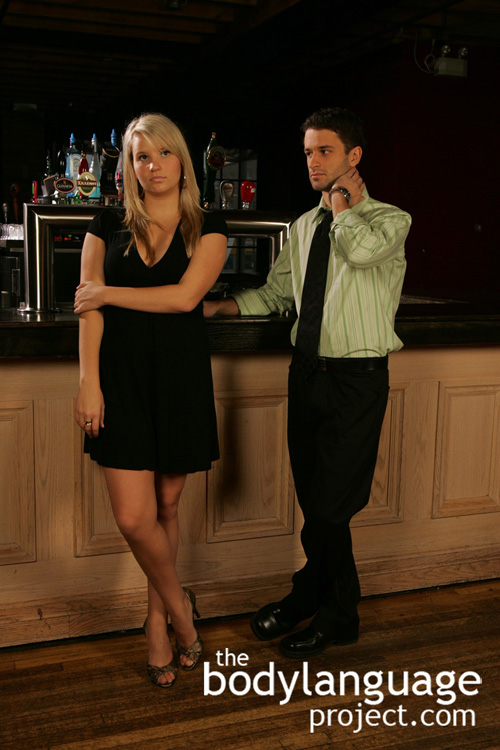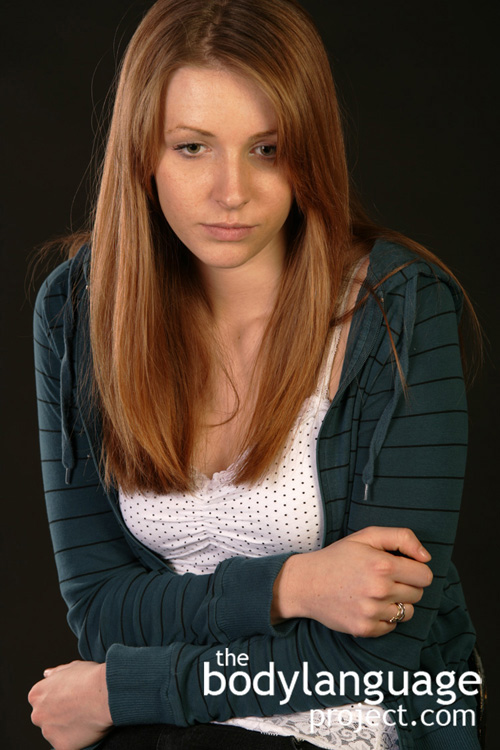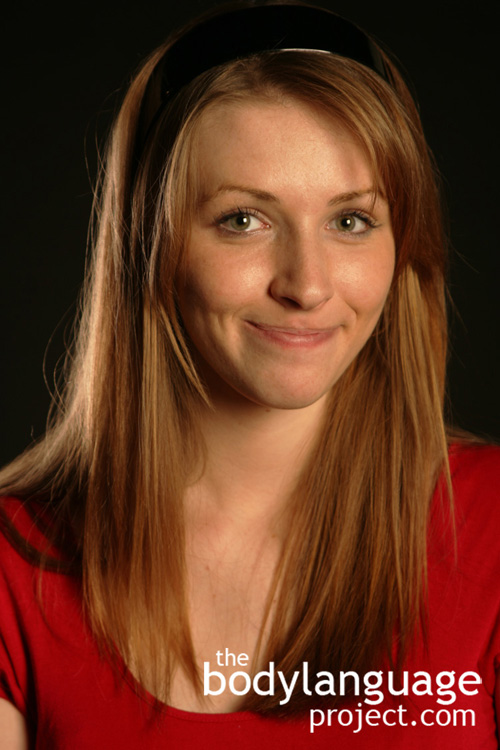Body Language of The Ankle Cross or Scissor Cross
 Cue: The Ankle Cross or Scissor Cross
Cue: The Ankle Cross or Scissor Cross
Synonym(s): Scissor Cross, Ankle-Ankle Cross, Interlocking Feet, Interlocking Legs, Ankle Lock, Foot Lock, Knotted Ankles, Ankle Cross Under Chair.
Description: While seated or standing, the ankle of one foot wraps around the ankle of the other foot.
In One Sentence: The ankle cross is a sign that one is showing restraint, discomfort or insecurity and also that one is not prepared to immediately leave.
How To Use it: Use the posture while standing to show that you are not immediate ready to vacate but rather are prepared to listen to someone else speak. This posture also shows submission which can be helpful in placating a domineering counterpart such as a boss. Finally, the posture can create a sense of security as it protects the genital area from over-exposure. Thus, in a crowded area, the ankle cross can make one feel more comfortable.
Context: a) Business, b) Social/Friendly and Dating
Verbal Translation: “I’m not totally comfortable, but I’m not going anywhere.”
Variant: The top of one foot locks around the leg of the other while seated or standing (mainly female posture). The feet might suddenly be pulled in under the chair withdrawing emotionally even further. This shows insecurity and discomfort.
Cue In Action: a) It was suggested that the company increase it’s workforce from ten to fifteen employees. Upon hearing the suggestions, Debbie from human resources wrapped her legs together at the ankles and pulled them under her chair showing passive disagreement. b) Long-time friends discussed politics while standing with their feet in a causal shoulder width stance. But when the topic switches to sports, and the discussion evolves, the feet of both parties cross. This shows that they are vested in the conversation, and aren’t thinking about escaping. c) The legs are wrapped around the legs of a chair sometimes called the Ejector Seat Posture (See Seated Readiness or The Ejector Seat Position and Feet Wrapped Around Legs Of Chair) showing anxiety, concern or discomfort.
Meaning and/or Motivation: While seated, a sudden locking of the feet indicates discomfort or insecurity. Conversely, if the feet are suddenly unlocked, the signal that the discomfort has been removed and that comfort is present.
When feet are crossed while standing, it indicates that a person is in no hurry to leave, and are that they comfortable discussing the topic.
a) While seated, it indicates that a person is holding a negative emotion, uncertainty, fear, anxiety, insecurity, reserved self-restraint, lack of confidence, or in general, uncomfortable or timid due to withholding a thought or emotion. It is a closed body posture and indicates that a person does not wish to budge and is likely holding negative attitude.
b) While standing, it is modest and formal and has no meaning at all unless the posture is adopted suddenly. When seated, the ankle cross indicates that modest comfort is present as crossed legs impede a quick escape. Other times it indicates negativity, defensiveness and insecurity especially if coupled with arm crossing or the Fig Leaf. Also shows commitment due to inability of making a quick escape, submission and sometimes vulnerability if coupled with a dipped head.
c) The person who locks their feet around the chair is bracing and locking (freezing) themselves as they have heard things they don’t want to hear, but aren’t permitted to leave.
Cue Cluster: Legs crossed at the ankles coupled with arm withdrawal, a scowling expression, and head turned away, amplifies the negative emotion communicated by the ankle cross. Couple interlocked legs, which is a freeze response meant to reduce foot movement, with pacifying behaviours such as rubbing the thighs palm down, as if to dry them, and you’ve got a cluster signaling that a secret is being covered. If the feet are pulled under the chair, the message is even more exaggerated. The feet are saying exactly what the person is thinking, that he or she is closed and withdrawn from the conversation.
Body Language Category: Disengagement, Defensive, Negative body language, Fearful body language, Discomfort, Stressful body language, Body cross.
Resources:
Adams, E.S., Mesterton-Gibbons, M., 1995. The cost of threat displays and the stability of deceptive communication. J. Theor. Biol. 175, 405–421.
Allen, Jill; Sarah J. Gervais and Jessi L. Smith. Sit Big to Eat Big: The Interaction of Body Posture and Body Concern on Restrained Eating. Psychology of Women Quarterly 2013. 37(3): 325-336. DOI: 10.1177/0361684313476477pwq.sagepub.com
Arnette, S. L., & Pettijohn, T. F., II. (2012). The effects of posture on self-perceived leadership. International Journal of Business and Social Science, 3, 8–13.
Bohns, Vanessa K. and Scott S. Wiltermuth. It Hurts When I Do This (Or You Do That): Posture And Pain tolerance. Journal of Experimental Social Psychology. 2012. 48: 341-345.
Briñol, P., Petty, R. E., & Wagner, B. (2009). Body posture effects on self-evaluation: A self-validation approach. European Journal of Social Psychology, 39, 1053–1064.
Burgoon, J. K., Johnson, M. L., & Koch, P. T. (1998). The nature and measurement of interpersonal dominance. Communication Monographs, 65, 308–335.
Bohns, Vanessa K. and Scott S. Wiltermuth. It Hurts When I Do This (Or You Do That): Posture And Pain tolerance. Journal of Experimental Social Psychology. 2012. 48: 341-345.
Cacioppo, J. T., Priester, J. R., & Berntson, G. G. (1993). Rudimentary determinants of attitudes: II. Arm flexion and extension have differential effects on attitudes. Journal of Personality and Social Psychology, 65, 5–17.
Carney, Dana R.; Amy J.C. Cuddy; Andy J. Yap. Power Posing: Brief Nonverbal Displays Affect Neuroendocrine Levels and Risk Tolerance. Psychological Science, 2010; 21 (10): 1363-1368.
Cesario, J., & McDonald, M. M. (2013). Bodies in context: Power poses as a computation of action possibility. Social Cognition, 31, 260–274.
Cuddy, A. J. C., Wilmuth, C., Yap, A. J., & Carney, D. R. (in press). Preparatory power posing affects nonverbal presence and job interview performance. Journal of Applied Psychology.
Fo¨rster, J. (2004). How body feedback influences consumer’s evaluation of products. Journal of Consumer Psychology, 14, 415–425.
Fischer, J., Fischer, P., Englich, B., Aydin, N., & Frey, D. (2011). Empower my decisions: The effects of power gestures on confirmatory information processing. Journal of Experimental Social Psychology, 47, 1146–1154.
Friedman, R. S., & Fo¨rster, J. (2000). The effects of approach and avoidance motor actions on the elements of creative insight. Journal of Personality and Social Psychology, 79, 477–492.
Friedman, Ron and Andrew J. Elliot. The Effect Of Arm Crossing On Persistence And Performance. European Journal of Social Psychology. 2008; 38, 449–461 (2008).
Gunderson, Virginia M. ; Lockard, Joan S. Human postural signals as intention movements to depart: African data. Animal Behaviour. 1980 28(3): 966-967.
Gregersen, Tammy S. Nonverbal Cues: Clues to the Detection of Foreign Language Anxiety. Foreign Language Annals. 2005. 38(3): 388-400
Harrigan, Jinni ; Oxman, Thomas ; Rosenthal, Robert. Rapport expressed through nonverbal behavior. Journal of Nonverbal Behavior. 1985 9(2): 95-110.
Huang, L., Galinsky, A. D., Gruenfeld, D. H., & Guillory, L. E. (2011). Powerful postures versus powerful roles: Which is the proximate correlate of thought and behavior? Psychological Science, 22, 95–102.
James, W. (1950). The Principles of Psychology. New York, NY: Dover. (Original work published 1890)
Laird, J. D., & Lacasse, K. (2014). Bodily influences on emotional feelings: Accumulating evidence and extensions of William James’s theory of emotion. Emotion Review, 6, 27–34.
Lee, E. H., & Schnall, S. (2014). The influence of social power on weight perception. Journal of Experimental Psychology: General, 143, 1719–1725.
Laird, J. D., Wagener, J. J., Halal, M., & Szegda, M. (1982). Remembering what you feel: Effects of emotion on memory. Journal of Personality and Social Psychology, 42, 646–657.
Lockard, J.S. ; Allen, D.J. ; Schiele, B.J. ; Wiemer, M.J. Human postural signals: Stance, weight-shifts and social distance as intention movements to depart. Animal Behaviour. 1978 26: 219-224.
Li Huang, Adam D. Galinsky, Deborah H Gruenfeld and Lucia E. Guillory. Powerful Postures Versus Powerful Roles: Which Is the Proximate Correlate of Thought and Behavior? 2011, Psychological Science; 22(1): 95–102.
Matsumura, Shuichi ; Hayden, Thomas J. When should signals of submission be given?–A game theory model. Journal of Theoretical Biology. 2006. 240(3): 425-433.
Marsh, Abigail A; Henry H. Yu; Julia C. Schechter and R. J. R. Blair. Larger than Life: Humans’ Nonverbal Status Cues Alter Perceived Size. PLoS ONE. 2009. 4(5): e5707. doi:10.1371/journal.pone.0005707.
Morris, Desmond (1994). Bodytalk: The Meaning of Human Gestures (New York: Crown Publishers).
Embodiment effects on depressive memory bias. Clinical Psychology & Psychotherapy, 21, 519–524.
Minvaleev, R. S., Nozdrachev, A. D., Kir’yanova, V. V., & Ivanov, A. I. (2004). Postural influences on the hormone level in healthy subjects: I. The cobra posture and steroid hormones. Human Physiology, 30, 452–456.
Nair, S., Sagar, M., Sollers, J., III, Consedine, N., & Broadbent, E. (2014). Do slumped and upright postures affect stress responses? A randomized trial. Health Psychology. Advance online publication. doi:10.1037/hea0000146
Neumann, R., & Strack, F. (2000). Approach and avoidance: The influence of proprioceptive and exteroceptive cues on encoding of affective information. Journal of Personality and Social Psychology, 79, 39–48.
Pease, Barbara and Allan Pease. 2006. The Definitive Book of Body Language Hardcover. Bantam.
Park, L. E., Streamer, L., Huang, L., & Galinsky, A. D. (2013). Stand tall, but don’t put your feet up: Universal and culturally-specific effects of expansive postures on power. Journal of Experimental Social Psychology, 49, 965–971.
Riskind, J. H., & Gotay, C. C. (1982). Physical posture: Could it have regulatory or feedback effects upon motivation and emotion? Motivation and Emotion, 6, 273–296.
Riskind, John H. Manis, Melvin (editor). They stoop to conquer: Guiding and self-regulatory functions of physical posture after success and failure. Journal of Personality and Social Psychology. 1984 47(3): 479-493.
Ranehill, Eva; Anna Dreber; Magnus Johannesson; Susanne Leiberg; Sunhae Sul and Roberto A. Weber. Assessing the Robustness of Power Posing: No Effect on Hormones and Risk Tolerance in a Large Sample of Men and Women. Psychological Science, March, 2015. doi: 10.1177/0956797614553946
Riskind, J. H. (1984). They stoop to conquer: Guiding and selfregulatory functions of physical posture after success and failure. Journal of Personality and Social Psychology, 47, 479–493.
Riskind, J. H., & Gotay, C. C. (1982). Physical posture: Could it have regulatory or feedback effects on motivation and emotion? Motivation and Emotion, 6, 273–298.
Stepper, S., & Strack, F. (1993). Proprioceptive determinants of emotional and nonemotional feelings. Journal of Personality and Social Psychology, 64, 211–220.
Strelan, P., Weick, M., & Vasiljevic, M. (2013). Power and revenge. British Journal of Social Psychology, 53, 521–540.
Sartori, Luisa ; Becchio, Cristina ; Castiello, Umberto. Cues to Intention: The Role of Movement Information. Cognition. 2011. 119(2): 242-252.
Schwartz, B., Tesser, A., & Powell, E. (1982). Dominance cues in nonverbal behavior. Social Psychology Quarterly, 45, 114–120.
Stepper, S., & Strack, F. (1993). Proprioceptive determinants of emotional and nonemotional feelings. Journal of Personality and Social Psychology, 64, 211–220.
Sturman, Edward D. Involuntary Subordination and Its Relation to Personality, Mood, and Submissive Behavior. Psychological Assessment. 2011. 23(1): 262-276 DOI: 10.1037/a0021499
Schenkel, Rudolf. Submission: Its Features and Function in the Wolf and Dog. American Zoologist. 1967. 7(2): 319-329.
Sporer, Siegfried L. ; Schwandt, Barbara Penrod, Steven D. (editor). MODERATORS OF NONVERBAL INDICATORS OF DECEPTION: A Meta-Analytic Synthesis. Psychology. Public Policy, and Law. 2007. 13(1): 1-34.
Tiedens, Larissa Z ; Fragale, Alison R. Power moves: complementarity in dominant and submissive nonverbal behavior. Journal of personality and social psychology. 2003. 84(3): 558-68.
Tracy, J. L., & Robins, R. W. (2004). Show your pride: Evidence for a discrete emotion expression. Psychological Science, 15, 194–197.
Tamir, M., Robinson, M. D., Clore, G. L., Martin, L. L., & Whitaker, D. J. (2004). Are we puppets on a string? The contextual meaning of unconscious expressive cues. Personality and Social Psychology Bulletin, 30, 237–249.
Welker, K. M., Oberleitner, D. E., Cain, S., & Carré, J. M. (2013). Upright and left out: Posture moderates the effects of social exclusion on mood and threats to basic needs. European Journal of Social Psychology, 43, 355–361.
Walsh, Joseph ; Eccleston, Christopher ; Keogh, Edmund. Pain communication through body posture: The development and validation of a stimulus set. Pain. 2014. 155(11): 2282-2290.
Yap, Andy J. Abbie S. Wazlawek, Brian J. Lucas, Amy J. C. Cuddy, Dana R. Carney. The Ergonomics of Dishonesty: The Effect of Incidental Posture on Stealing, Cheating, and Traffic Violations, 24(11); 2281-2289.





